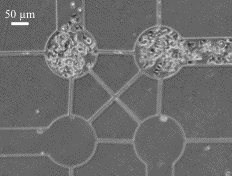Summary
NIST has taken advantage of recent technological advances to develop polymer microfluidic cell culture systems that provide a level of control over the cellular microenvironment unmatched in conventional cultures. Cell behavior is powerfully modulated by local extracellular cues such as: soluble signaling molecules and dissolved gases, the chemistry and mechanics of the extracellular matrix, and the proximity and behavior of neighboring cells. Additionally, cells respond to spatial and temporal variations in these environmental cues. The goal of this project is to improve cell-based assays through the development of microfluidic systems that control these extracellular cues (e.g. cell position and/or arrangement; substrate surface chemistry).
Description

Intended impact:
Cell behavior is powerfully modulated by local extracellular cues. However, the number of parameters that affect cell behavior is large, and include soluble signaling molecules, dissolved gases, the chemistry and mechanics of the extracellular matrix, and the proximity and behavior of neighboring cells. Additionally, cells respond to spatial and temporal variation in these environmental cues. By engineering the extracellular cues presented to cells in culture, hypothesis can be tested that are inaccessible using traditional cell culture systems.
Objective(s):
Develop strategies to improve control over the cellular microenvironment in microfluidic cell culture systems. Specific objectives include strategies within the microfluidic system to control: the dissolved gas concentration (e.g. O2, CO2); the position and organization of cells, including cellular spacing; the insoluble extracellular matrix presented to cells; and the rapid, but gentle, introduction of novel soluble species (e.g. enzymes or toxins).
Enable integration of cell culture with automated analysis on the same microfluidic device with access to optical imaging, electrochemical interrogation, controlled lysis of desired cells, and collection of cell contents for downstream analysis.
Goals:
- Demonstrate on-chip control of dissolved gas composition
- Control the position of individual cells within microfluidic systems using electronic manipulation and immobilization
- Integrate well-controlled cellular microenvironments with continuous, real-time cellular analysis
- Validate microfluidic cell culture systems against conventional cell-based assays
- Evaluate the effect of extracellular matrix composition on microfluidic cell culture systems
- Introduce parallelization of microfluidic cell cultures to improve throughput of microfluidic cell culture experiments
Major Accomplishments
- Demonstrated on-chip modulation of CO2 partial pressure and utilized CO2 control to enable sustained microfluidic cell culture
- Characterized the immobilization of suspended cells at transparent microelectrodes within microfluidic devices
- Developed protocols for depositing extracellular matrix within microfluidic cell culture systems
NIST has taken advantage of recent technological advances to develop polymer microfluidic cell culture systems that provide a level of control over the cellular microenvironment unmatched in conventional cultures. Micro- and nano-fabrication allows reproducible construction of engineered biomimetic microenvironments on the cellular length scale (~5µm - 500µm) in geometries that are readily parallelized for high throughput applications. These microfluidic cell cultures can include complex topographies, definable surface and solution chemistries, nonrandom organization of cells of different types, and flow conditions that mimic the flow of in vivo capillary networks.

